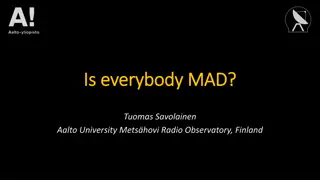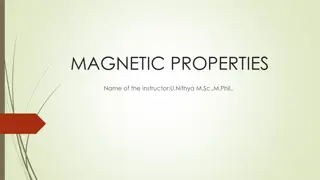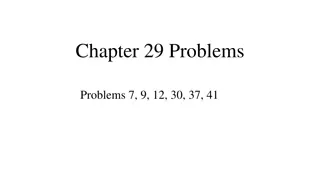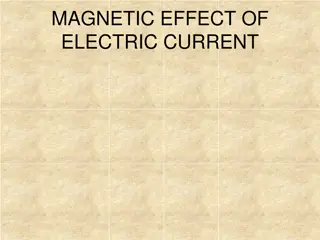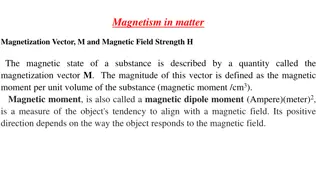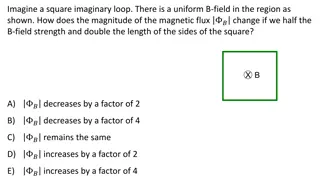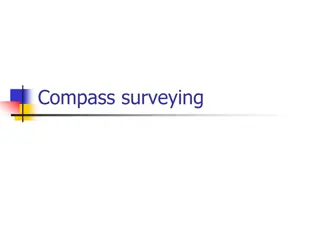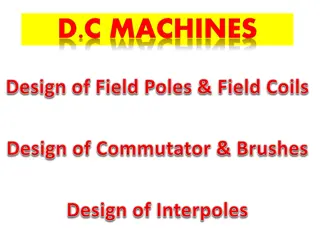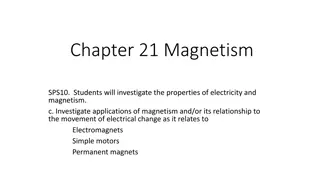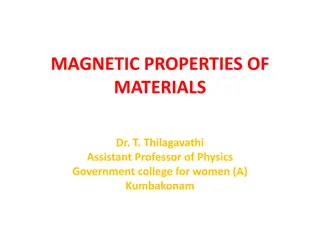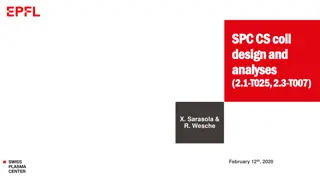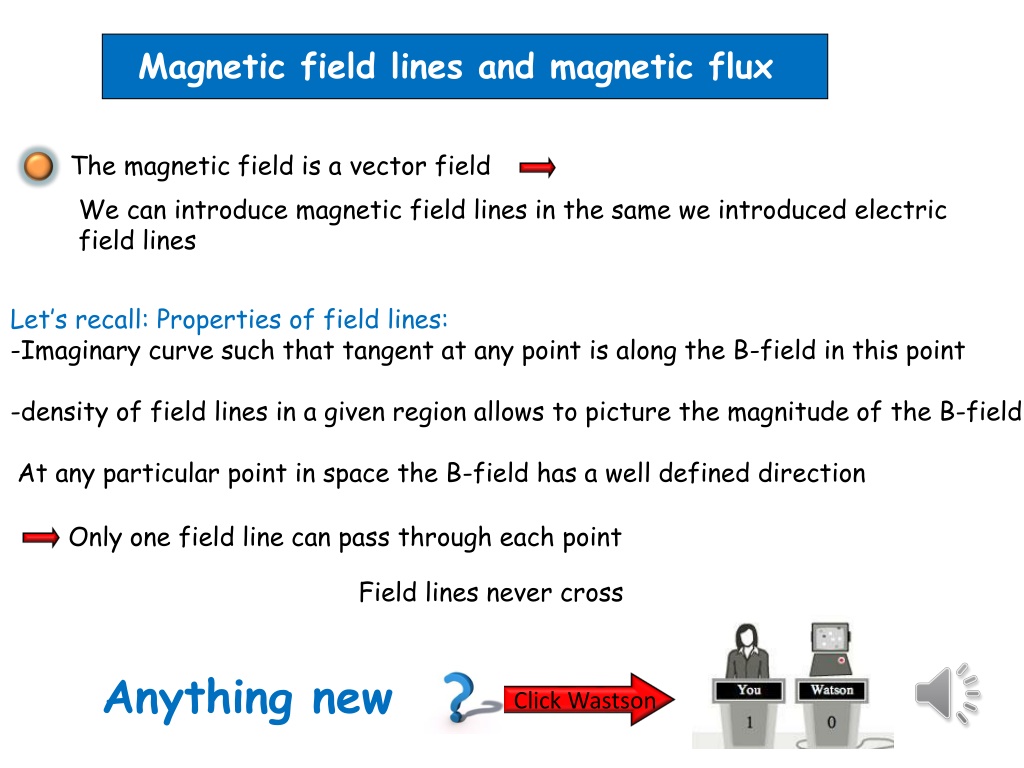
Understanding Magnetic Field Lines and Flux
Magnetic field lines provide a visual representation of the direction of the magnetic field, similar to electric field lines. They help visualize the magnetic field's strength and direction. Cutting a permanent magnet in half results in two dipoles. Magnetic flux, a scalar quantity, is defined over a surface by integrating the magnetic field. There is an analog of Gauss's Law for magnetic flux, showing the absence of magnetic monopoles.
Download Presentation

Please find below an Image/Link to download the presentation.
The content on the website is provided AS IS for your information and personal use only. It may not be sold, licensed, or shared on other websites without obtaining consent from the author. If you encounter any issues during the download, it is possible that the publisher has removed the file from their server.
You are allowed to download the files provided on this website for personal or commercial use, subject to the condition that they are used lawfully. All files are the property of their respective owners.
The content on the website is provided AS IS for your information and personal use only. It may not be sold, licensed, or shared on other websites without obtaining consent from the author.
E N D
Presentation Transcript
Magnetic field lines and magnetic flux The magnetic field is a vector field We can introduce magnetic field lines in the same we introduced electric field lines Let s recall: Properties of field lines: -Imaginary curve such that tangent at any point is along the B-field in this point -density of field lines in a given region allows to picture the magnitude of the B-field At any particular point in space the B-field has a well defined direction Only one field line can pass through each point Field lines never cross http://singularityhub.com/wp-content/uploads/2010/06/IBM-watson-jeopardy-challenge.jpg Anything new Click Wastson
Magnetic field lines are not force lines ! So what do they visualize then: Magnetic field lines have the direction that a compass needle would point at each location Examples of magnetic field lines Right hand rule gives direction of field Current through wire Permanent magnet
Clicker question What happens if you cut a permanent magnet in half? 1) You get a separate north pole and south pole similar to electric plus and minus charges 2) There is no magnetic charge. Any permanent magnet has two poles, if you cut a magnetic dipole in half you end up with two dipoles.
Magnetic flux The magnetic field is a vector field we can define a magnetic flux Remember: Flux : scalar quantity, , which results from a surface integration over a vector field. = magnetic flux through surface B d A B A vector field The SI unit of magnetic flux [ ][ ] B B A = Wb read Weber in honor of Wilhelm Weber = = 2 T m Wb surface File:Wilhelm Eduard Weber II.jpg
Is there something like Gauss law for magnetic flux Yes, and it surprisingly simple with deep fundamental meaning Remember Gauss law for electric flux and let s apply it by enclosing electric dipoles: Since the total enclosed charge is zero we have enclosed Q = = = 0 E d A E 0 has never been observed (and that is why physicists keep looking for it -> I want my Nobel prize ) Since there is no such thing as magnetic monopoles 0 B d A= The magnetic flux through any closed surface is zero (magnetic monopoles have never been observed, magnetic field lines always close ) If you don t feel sufficiently confused yet read also Have physicists seen magnetic monopoles?
Magnetic force on a current carrying conductor Let s consider a conducting wire carrying a current I=jA in a B-Field to the current density vector j Lorentz force on an individual charge q with drift velocity vd (remember Drude model) reads = F For N charges we have therefore a total force F Nqv B = In the wire of volume V=l A we have N=n lA charges q qv B d d = using the transport expression for the current density j j qnv v qn F nlAqv B d = = d d = = = F l Aj B F F I l B I l B If B makes an angle with the wire sin I
= F Where l is a vector pointing in the direction of the current and has the magnitude l I l B If the conductor is not straight consider infinitesimal short segments contributing withdF = I dl B = F dF Example: Magnetic force on a curved conductor Let s find the total magnetic force on the conductor Start with the straight segment: e e e = = l B le Be x l y z x = = 0 0 0 B l B lBe y 0 z = F IlBe straight y
Curved part: ( ) = cos ,sin ,0 r R dr d R d ( ) = = cos ,sin ,0 dl d R d ( d ) = sin ,cos ,0 dl d e e e x y z I d = = sin 0 cos 0 0 B R R F dF curved 0 I d = = + sin cos cos sin IRBe IRBe RB e RB e x y x y 0 0 0 = 2 IRBe y ( ) = + 2 F IB l R e total y The force a straight wire of length l+2R would experience. That makes sense when considering the symmetry. Luke, the Force runs strong in your family. Pass on what you have learned. Luke, the Force runs strong in your family. Pass on what you have learned. If you think you deserve a break see also http://www.youtube.com/watch?v=o7ENNyGlmQY
Force and torque on a current loop = /2 r b r1 with 1 Fb = sin T 1 2 r = /2 b r2 with 2 Fb = sin T 2 2 = sin T Fb = sin IBab = sin T IA B Magnitude of torque on current loop Image from our textbook Young and Freedman
Lets generalize into a full vector notation = sin T IA B =: the absolute value of the magnetic moment of the loop We are used to assign a vector to an area = It appears natural to define a vector I A A is normal to the loop area. Its direction is determined by the right hand rule Since is the angle between and B = T B Vector torque of on current loop This equation is in wonderful analogy to the torque on an electric dipole in an E-field
The direct current motor Click here for a java applet https://nationalmaglab.org/education/magnet-academy/watch-play/interactive/dc-motor T B From the right hand rule we get direction of the magnetic moment B-field points from N to S Determines the direction of

